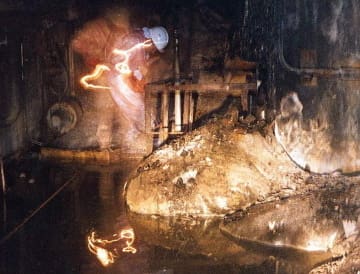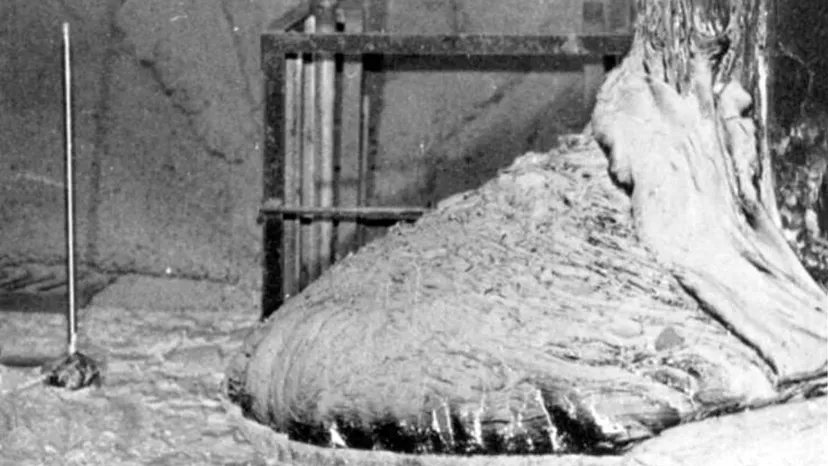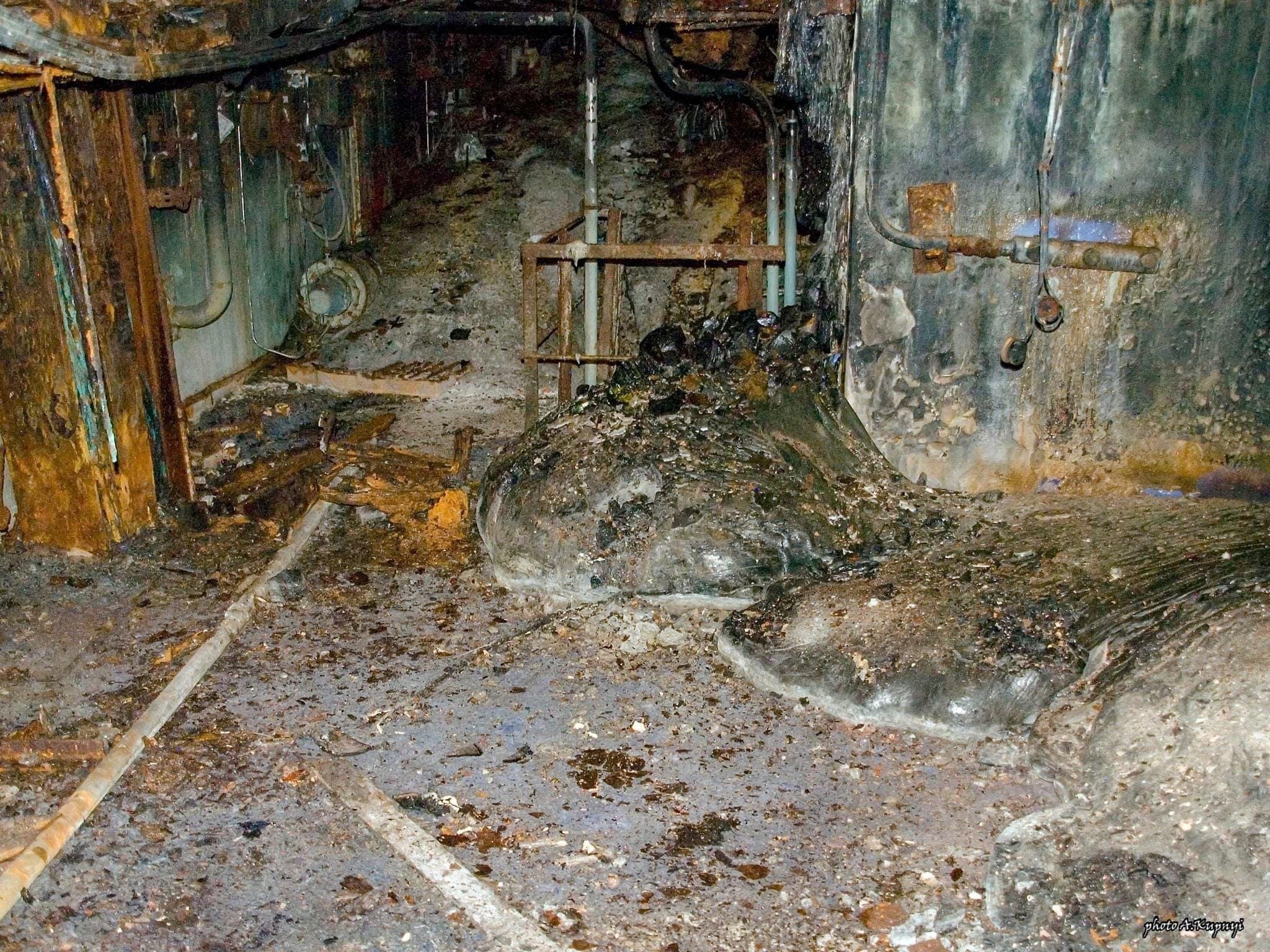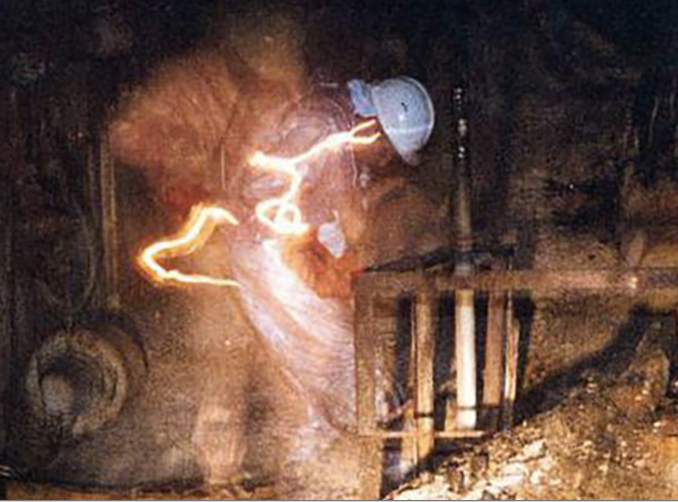Imagine this: you’re navigating the desolate, eerie hallways of a place time forgot, and you stumble upon a mass so deadly, just chilling in the same room with it for a quick five minutes could send you packing… permanently. This isn’t the setup for the latest horror flick or some dark fantasy novel. This is real life, or rather, the aftermath of a reality that once went terribly awry in a place called Chernobyl.
At the heart of this narrative lies the Elephant’s Foot—a testament not just to a monumental oops in nuclear history but to a bizarre, almost mythical emblem of human resilience mixed with a generous dose of folly.
So, here’s the deal: this story isn’t your run-of-the-mill history lesson. Nope. Think of it more as a jaunt through the annals of “How Not to Handle a Nuclear Reactor,” with a side of edgy humor and a whole lot of jaw-dropping facts that’ll make you go, “Wait, what?!”
Welcome to the unveiling of the deadliest artifact in nuclear history. Buckle up, folks—it’s gonna be a wild ride.
The Elephant’s Foot, Chernobyl – Birth of a Monster
The Night That Changed Everything
Let’s rewind to that fateful night in 1986—April 26th, to be exact. It was a night that could’ve been ripped straight from the script of a disaster movie, except this was no Hollywood spectacle. The Chernobyl Nuclear Power Plant, nestled in the heart of the Soviet Union, became the stage for what would be the worst nuclear disaster the world had ever seen. Reactor No. 4 went kaboom, but not with a bang you’d hear. Instead, it was a catastrophic meltdown that silently screamed its way into the annals of infamy. Imagine the confusion, the disbelief, and the sheer panic as the realization set in: This was not a drill.
From Meltdown to Solid Ground
Fast forward through the chaos, and amidst the ashes and radioactive dust, a peculiar formation took shape. Enter the Elephant’s Foot—a mass of corium, a once-molten concoction of nuclear fuel, concrete, and everything else unfortunate enough to be in its path as it burned its way through the reactor floor. Picture the Blob, but make it radioactive and, frankly, a lot less friendly.
This monstrous mass wasn’t just a freak of nature; it was a scientific anomaly. Formed in the heat of a nuclear meltdown, the Elephant’s Foot was so named for its wrinkled, grayish appearance, resembling the foot of an elephant if that elephant had waded through a nuclear fallout zone. Its existence is a stark reminder of the raw power of unbridled nuclear energy—both mesmerizing and terrifying in equal measure.
The sheer lethality of this artifact is the stuff of legends. Initially, standing in its presence for a mere 300 seconds was a death sentence—talk about not overstaying your welcome. But the Elephant’s Foot was more than just a radioactive oddity; it was a glaring, unmovable symbol of the consequences of human error, a testament to the fine line between groundbreaking science and catastrophic disaster.
Close-up on The Beast
What’s in a Name?
You might wonder, “Why the heck is it called the Elephant’s Foot?” It’s not just because someone thought it looked whimsically like Dumbo’s foot dipped in nuclear waste. When the first responders and scientists laid eyes on this radioactive mass, its wrinkled, grayish exterior and bulky shape reminded them of an elephant’s foot. There’s a certain irony in naming one of the deadliest artifacts in human history after something as sturdy and steadfast as an elephant’s foot. It’s like nature’s cruel joke—combining the symbol of longevity and strength with a deadly, ticking time bomb.
Radioactive Behemoth
Diving into the nitty-gritty, the Elephant’s Foot was not your garden-variety radioactive mass. Early measurements pegged its radiation levels at an off-the-charts 10,000 roentgens per hour. To put that in perspective, imagine a radiation dose so potent, even a brief encounter could hammer the final nail in your coffin. This wasn’t just any artifact; it was a death sentence encapsulated in a mass no larger than your average living room sofa.
Yet, the true allure of the Elephant’s Foot isn’t just its deadly embrace but the sheer audacity of its existence. It stands (well, sits) as a testament to the raw, unfiltered power of nuclear energy gone rogue. Scientists, wearing what might as well have been tin foil hats for all the good they would do against such radiation, ventured as close as they dared, attempting to unravel the secrets of this lethal curiosity. Their efforts have given us invaluable insights into nuclear safety, reactor design, and disaster mitigation—lessons bought with bravery and, unfortunately, lives.
The Elephant’s Foot, for all its danger, has mellowed out over the years. Don’t get me wrong—it’s still no picnic spot, but its radiation levels have dropped to the point where it’s possible to spend a few minutes in its presence without turning into a comic book superhero. Or, more accurately, without suffering immediate radiation poisoning. This gradual decline in its radioactive clout offers a glimmer of hope, a testament to the resilience of both human ingenuity in containing it and nature’s ability to endure and adapt.
The Legacy of the Foot
A Silent Guardian
In the aftermath of its chaotic birth, the Elephant’s Foot morphed from a deadly curiosity into a silent guardian of Chernobyl’s twisted legacy. Think of it as the nuclear world’s version of a lighthouse: a beacon warning of the dangers lurking in the misuse of atomic energy. Its presence serves as a stark reminder of the day humanity’s grasp on nuclear power slipped, unleashing forces we were scarcely prepared to contain.
The containment efforts around this behemoth are nothing short of heroic—a ballet of science, engineering, and sheer will to prevent further catastrophe. Encasing the reactor in a sarcophagus and later, the New Safe Confinement, was akin to putting a band-aid on a bullet wound, but it worked. Sort of. The Foot remains ensconced in its concrete tomb, a radioactive King Tut, whispering its silent warnings to those who dare to listen.
Living with the Monster
The area surrounding Chernobyl, famously known as the Exclusion Zone, has become a bizarre testament to nature’s resilience. Wild animals roam the abandoned towns; plants reclaim the crumbling edifices of a once-thriving community. It’s like Mother Nature looked at the radioactive fallout and said, “Challenge accepted.”
Yet, the Elephant’s Foot remains a potent symbol of human error amidst this regrowth. It’s a morbid tourist attraction for the daring (or foolish), and a case study for scientists and safety experts determined to prevent a repeat of the past. The Zone offers a unique glimpse into a post-apocalyptic world, where the earth heals itself in the face of human folly.
Traveling to Chernobyl isn’t your typical holiday getaway. It’s more of a pilgrimage—a journey made by those looking to understand the depths of human ambition and its consequences. For the intrepid souls who venture there, the experience is a mix of awe, horror, and a profound respect for the power we wield. And if you’re planning on visiting, remember: respect the boundaries, follow the rules, and maybe pack some lead-lined underwear. Just kidding. (Or am I?)
The Foot’s Message to the World
As we stand in the shadow of the Elephant’s Foot, it’s crucial to reflect on the message it imparts. This isn’t just a relic of a bygone disaster; it’s a mirror reflecting our own hubris, a reminder of the razor-thin line between mastery and disaster. In its silent vigil, the Foot beckons us to tread carefully as we navigate the atomic age, urging us to remember the cost of oversight and the value of caution.
The legacy of the Elephant’s Foot extends beyond the confines of the Exclusion Zone, touching on themes of environmental stewardship, the ethics of scientific advancement, and the importance of learning from our past. As we continue to harness the atom’s power for both energy and medicine, the Foot serves as a grounding force, a reminder that with great power comes great responsibility.
Lessons from the Ashes
Playing with Fire
The story of the Elephant’s Foot is a stark reminder of what happens when the flames of innovation are not tempered with the foresight of safety. Chernobyl was not just a failure of technology but a failure of humanity to recognize the bounds of its own hubris. It’s a lesson writ large in the annals of history, teaching us that playing with fire—be it the fire of the gods or the atom—demands respect, caution, and above all, humility.
Yet, from the ashes of this disaster, we’ve gleaned invaluable insights. The global response to Chernobyl catalyzed advancements in nuclear safety, reactor design, and emergency preparedness. It was a wake-up call, echoing through the corridors of power plants worldwide, urging a reevaluation of protocols and safeguards. The legacy of Chernobyl, and particularly the Elephant’s Foot, has thus become a cornerstone of nuclear safety education, a grim tale that underscores the importance of diligent oversight and the perpetual quest for improvement.
Nuclear Safety 101
In the years following the disaster, the world didn’t turn its back on nuclear power—instead, it learned to embrace it more wisely. The Elephant’s Foot, in its deadly silence, speaks volumes about the necessity of rigorous safety measures, continuous learning, and the unyielding pursuit of technological excellence. It’s a reminder that while the atom offers us a bountiful source of energy, it demands our respect and diligence in return.
Modern nuclear reactors are marvels of engineering, designed with layers upon layers of safety systems, redundant protections, and fail-safes, all built on the lessons learned from past failures. The dialogue about nuclear energy has evolved, too, from one of fear and trepidation to a balanced discussion about its role in combating climate change and securing our energy future. The conversation is nuanced, reflecting a matured understanding of nuclear power’s potential and perils.
Conclusion: A Legacy Carved in Radioactive Stone
The Elephant’s Foot of Chernobyl stands as a monument to human fallibility and resilience. It’s a powerful narrative that intertwines the awe of scientific achievement with the solemnity of its potential for destruction. As we move forward, the story of the Elephant’s Foot urges us to proceed with caution, armed with the knowledge of the past and a commitment to a safer, brighter future.
This journey through the heart of Chernobyl, into the shadow of the Elephant’s Foot, is more than a tale of disaster; it’s a testament to our enduring spirit, our capacity for learning, and our unending quest to harness the forces of nature. It’s a story of darkness and light, of errors and insights, and of a future that, hopefully, learns from the echoes of the past.




